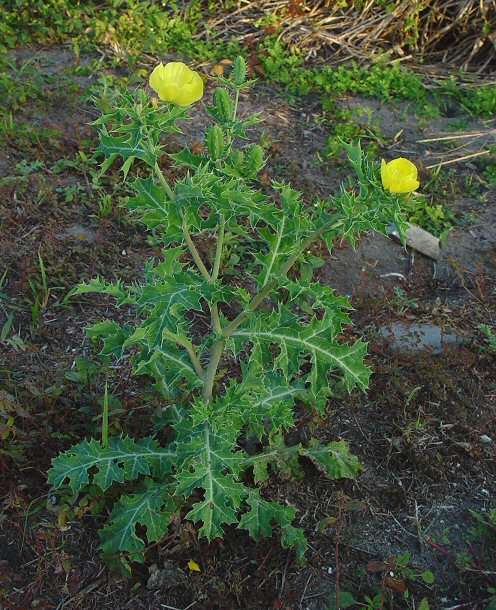Argemone mexicana L.
Devil's Fig

Introduced
CC = *
CW = 5
MOC = 8
© DETenaglia
Argemone mexicana L.Devil's Fig | |
 |
Introduced CC = * CW = 5 MOC = 8 |
© DETenaglia |
|
Family - Papaveraceae Habit - Taprooted annual or biennial forb. Stems - Ascending to erect, herbaceous but stout, to 0.8 m, single or multiple from the base, branching in the upper half, terete, glaucous, sparsely prickly, with yellow sap.
Leaves - Basal and alternate on the stems, to 25 cm, the stem leaves progressively shorter toward the stem or branch tips, all sessile, at least the uppermost leaves usually with a pair of rounded auricles at the base, clasping the stem. Leaf blades moderately to deeply pinnately lobed with relatively broad, often U-shaped sinuses, with irregularly toothed margins, these armed with staw-colored, slender prickles, the surfaces glabrous or with scattered slender prickles along the main veins, glaucous, with lighter mottling along the main veins. Inflorescence - Flowers terminal, loose clusters or solitary flowers at the stem or branch tips, the flowers short- to long-stalked, the stalk erect or ascending at flowering, closely subtended by 1 or 2 reduced leaflike bracts, the receptacle slightly expanded at the tip. Flowers - Sepals 3, free, the body 9-18 mm long, oblong elliptic, broadly pointed at the tip, sometimes prickly, also with a prominent, ascending, conic, dorsal horn near the tip. Petals 4, to 3.5 cm, broadly obovate, broadly rounded and often somewhat uneven or slightly ruffled at the tip, white to pale yellow or yellow. Stamens 20-50. Ovary lacking a well-differentiated style at flowering, the stigma more or less capitate, with 4-6, shallow, spreading lobes.
Fruits - Capsules to 45 mm long, oblong to ellipsoid in outline, the surface unarmed or sparsely to moderately prickly.
Flowering - May - August. Habitat - Rocky open ground, disturbed areas, roadsides, railroads. Origin - Native to the southeastern U.S., West Indes and Central America. Other info. - This species is sporadic and uncommon in Missouri, collected from just a handful of counties. The plant, although from a semi-tropical climate, is remarkably well adapted to colder and drier conditions. Photographs taken in Kissimmee, FL., 2-12-03, and in Winter Haven, FL., 12-23-03. |